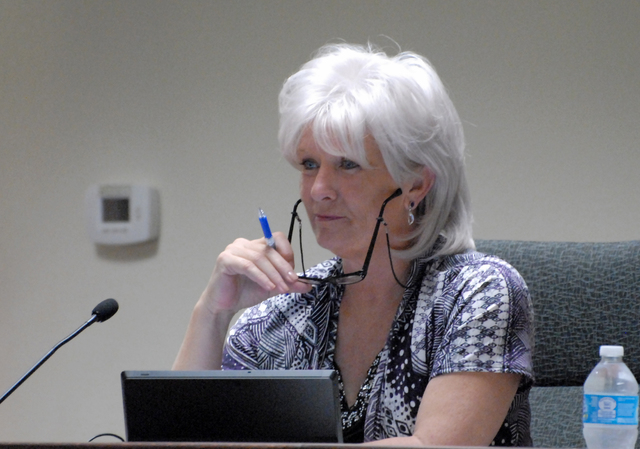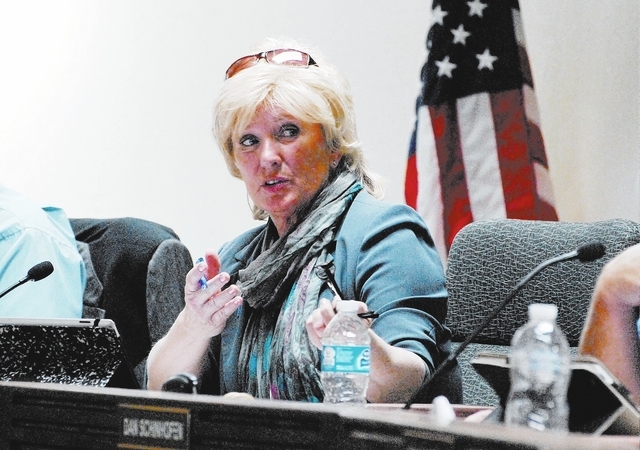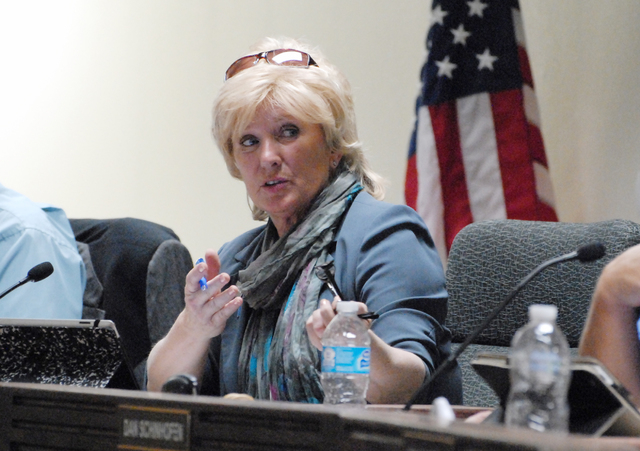Wichman pleads for renewable energy revenue sharing
The Senate Energy and Natural Resources Committee heard about the financial woes of Nye County from Commissioner Lorinda Wichman, who testified in favor of a bill streamlining renewable energy on public lands and ensuring local governments benefit from the royalties.
The committee held a hearing on the Public Lands Renewable Energy Development Act, introduced by U.S. Sen. Dean Heller, R-Nev., and U.S. Sen. Jon Tester, D-Mont., which Heller said attempts to break the logjam at the U.S. Bureau of Land Management to efficiently process permits for energy production on federal lands.
Nye County Commissioners ratified Wichman’s testimony last week after she appeared before the committee.
“Considering more than 87 percent of Nevada’s land is owned by the federal government, creating a more efficient permitting process for renewable energy on public lands is a win-win situation for all parties involved,” Heller said. “This legislation promotes the development of domestic energy resources on public lands while protecting native wildlife habitat and investing in our state and counties.”
Currently, obtaining Bureau of Land Management permits for solar and wind projects on public lands can take years – without any rights to the land until after all the environmental assessments are completed and with full permit approval. The Public Lands Renewable Energy Development Act creates a leasing pilot project to devise a straightforward process treating renewable energy development similar to traditional sources of energy development such as oil and gas. Heller said this more stable and efficient process makes long-term planning for companies easier.
The changes in this legislation ensure local governments benefit from projects regardless of where the power is sold, establishing a direct royalty system from renewables supporting conservation, public works, and federal land access projects.
Wichman, who is also president-elect of the Nevada Association of Counties and sits on a public lands steering committee for the National Association of Counties, said the bill provides for a more equitable and efficient path to the development of the nation’s diversified energy portfolio and has an extremely diverse base of sup0port.
Wichman said her county commission district, possibly the largest in the U.S. at 17,933 square miles, includes the Nevada National Security Site, Nellis Air Force Base, Ash Meadows National Wildlife Refuge, Yucca Mountain, Round Mountain Gold, the Railroad Valley oil fields, the Crescent Dunes renewable energy project and parts of Death Valley National Park. But 98 percent of the county is owned, managed or controlled by the federal government, she said.
In her prepared remarks, Wichman said the vast distances require her to travel 86 miles one way to attend county commission meetings in Tonopah and 252 miles one way to attend meetings in Pahrump.
“Our operating revenues have steadily declined since 2008 due mostly to the assessed values of property which is one-third of the pre-2008 values. The county operating budget for fiscal year 2014-2015 is now only $30 million. We have reduced our workforce by 15 percent and unfortunately a large part of the reduction was in law enforcement. We have consolidated services and restricted the purchase of non-essential supplies.
“Our infrastructure, buildings and grounds are suffering from lack of improvements. Payments in lieu of taxes provide us with $2 million to $3.5 million a year or 33 cents per acre. Our private property taxes are collected on only 2 percent of Nye County because of the overwhelming federal presence. Despite these obstacles, Nevada counties are required to provide essential services to all of their residents and visitors. Therefore it is easy to understand why Nye County and the state and national associations are encouraging the revenue sharing.”
While Nevada has an abundance of natural resources, Wichman said current management practices and the permitting process discourage many from pursuing projects on federally managed lands. Company feasibility studies take eight years and hundreds of thousands of dollars to get through the process, she said.
“Nevada has abundant wind, solar, geothermal, mineral and land resources, which position us to be one of the top states in attracting development of alternative energy projects. Streamlining the process to realize the benefits of production is paramount to our future success and allows counties to play a greater role in helping the state recover from its economic crisis,” Wichman said. “Passage of this legislation will lay the foundation to help industry to generate the funds needed by counties to provide critical services to my neighbors, Nye County, the state of Nevada and our nation.”
Heller picked up on Wichman’s comments, pointing out the mining, energy, ranching, timber and outdoor recreation industries serve as an important pillar in Nevada’s history, but these industries are struggling due to the price of doing business on federal land.
“One company told me, ‘It is becoming bad business to even try to get a project off the ground when federal lands are involved,’” Heller said. “It is no coincidence that our public lands counties are suffering from unemployment rates well above the national average. We have to get the federal government out of the way of our job producers so our western states can capitalize on their energy potential and can drive the nation’s 21st century energy strategy.”
In 2013, Nevada ranked second in the nation for geothermal production and third for solar production, Heller said, 18 percent of the state’s total electricity generation came from renewables, well above the national average of 13 percent.
In introducing Wichman, Heller told the congressional panel, “Nye County has some of the best sunshine for solar development in the entire country, we just need to get the federal government out of the way so it can be utilized.”



















